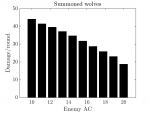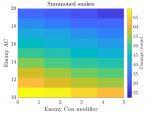Since the beast companion takes an action to attack, I generally conceive of it as an alternate weapon. That you can attack with at range. For good damage. And often an additional effect like prone. And that comes with an HP total and defenses that monsters can target instead of you. And that has skills like Perception that increase the number of checks a party gets.
It'd be like if wizards got a cantrip that dealt 1d8 damage and knocked a creature prone and provided an extra 10 temp hp and advantage on Wisdom checks and imposed disadvantage on all attacks.
...not sure that the companion is powerful enough, but it's not nothin'.
That's an interesting take on it. It makes sense, and I can see that that might have been what they were going for.
My problem with it is that they are
assuming that nobody is using Animal Handling, Persuasion, or gold to get themselves companions that don't require a class feature. I mean, for 200 gp you can have an elephant (which is superior to most Beastmaster companions until higher levels). You can ride that elephant and choose to allow it to act independently. You now can take all of your own actions, while having an elephant trampling and goring your foes.
If you have a Hunter and Beastmaster in the party, the Hunter could just buy/raise a nice pet of some sort, who will act independently whilst the Hunter gets their extra combat features. I'd feel rather cheated if I played a Beastmaster and realized the Hunter's companion was as good or better than mine (especially if it gets multiple attacks), and mine just stood around waiting to be commanded like a puppet (and not necessarily even getting it's full normal attack routine!) Of course, there is nothing stopping me, as a Beastmaster, from also picking up a non-class feature companion identical to my Hunter friend's. At that point you can compare the benefit of the Beastmaster's companion vs. the Hunter's features directly. Even if it turns out that the Beastmaster is just as effective in that situation (both rangers have a non-class feature companion, Beastmaster has his class-feature companion also), it feels wrong.
I mean, it seems like your special animal companion ought to be as good of a combatant as a regular trained creature, rather than turning into a brain-dead ranged weapon when you bond with him.
Maybe the DMG will mentions something about this in the section about companions. Something along the lines of, "If you choose to allow your PCs to have henchmen, trained creatures, or other companions, you should allow companions granted by class features (such as the Beastmaster's animal companion, or the Chain pact warlock's familiar) to act independently during combat. When a class feature allows the PC to grant actions or abilities to their companion, these are in addition to the creature's normal actions on its turn."
I'd really like to see something like that in there, but if Mike hasn't thought about it by now, it's probably too late. If I knew how to fit it into a tweet I'd send one, but that would be a bit hard to condense.




